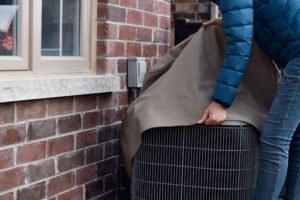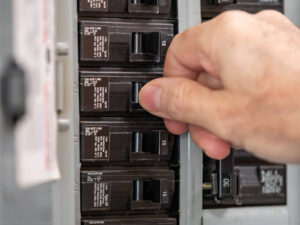
Turning on AC After Winter: 5 Important Steps
There’s no better feeling than saying goodbye to chilly weather and hello to warmer days. But before you switch your air conditioning system back on
A standard “split system” heat pump is a two-part appliance that uses refrigerant and electricity to provide heating and/or cooling for areas that need conditioning, such as a home, business, or another type of property. A standard “split system” heat pump has two components — a condenser unit that most often sits outside of a home and produces the heating or cooling, and an indoor unit that typically sits in an attic, closet, basement, garage, or within a crawl space and passes hot or cool air into the home via ductwork.
Other common systems are referred to as “mini-split” heat pumps, which offer very high efficiencies, as well as the ability to provide heating and cooling without the need for ductwork in the home. Since ductwork is not required, you may hear these heat pumps referred to as “ductless” as well.
A heat pump uses electricity and refrigerant to relocate heat energy from one location to another. A heat pump is very similar to a standard air conditioner, as it uses the same principles of air conditioning design. A heat pump can reverse its operation in order to pump heat gathered from the cooler air outside to the inside of the home. Because the heat pump can reverse its operation, it will do the opposite in the summer by removing heat from the air within the home and blowing it off outdoors.
A heat pump uses electricity only for power rather than for the creation of heat itself, resulting in much higher energy efficiency than electric resistance heat (baseboard or space heaters). The amount of heat generated is proportional to the amount of electricity used. One unit of heat per unit of electricity, with resistance heat, yields 100 percent efficiency, which sounds like a lot until we look at heat pumps that boast as much as 300 percent. Instead of powering a resistance heat strip and fan, heat pumps only use power for an outdoor fan, an indoor fan, and a compressor, which all use far less energy than a resistance heat strip. All of this means a lower electricity bill. You’ll find additional benefits to running a heat pump in conjunction with another heating system, such as a gas or oil furnace, which can offset the primary fuel. A heat pump can generally offset up to three hundred (300) gallons of oil in a typical home, saving money on fossil fuels, all the while reducing the home’s carbon footprint.
While both heat pump systems are very similar in design, geothermal heat pumps gather heat energy from either the ground, groundwater using a drilled well, and, in some cases, a lake or pond adjacent to the residence. A standard heat pump system gathers its heat energy from the outside air. Geothermal systems do not typically have an outdoor unit like standard heat pump systems and require larger investments made in drilling a well, excavating for ground source loop piping, along with water pumps in order to move water from the exterior of the residence to the interior air handler. Geothermal systems can save a substantial amount of energy but also require a very substantial investment and require more maintenance.
While there are a number of factors that can determine when to replace a heat pump, the majority most often depends on the consumer and the system in question. Here are a few things to consider:
Perhaps, but probably not. Reputable contractors size heating and air conditioning systems using a very stringent process called heat load calculation. Systems must be properly sized in order to meet the design temperature of the home, which takes into account everything from square footage, insulation, wall, ceiling and floor construction, windows, doors, stories, usage, and where the sun sets and rises in relation to the home, etc. Oversizing a unit can lead to the unit “short cycling.” This is when a unit quickly heats or cools the home, turns off, then starts the process over again in a short amount of time, resulting in a diminished life expectancy of the new system and poor removal of humidity. Proper design also takes into account ductwork sizing. A larger heat pump may require larger ductwork. Undersized ductwork on a system can also result in diminished life and damage to the ductwork itself.
This can vary, depending on how much the system is used, the region in which it has been installed, how well the initial installation was completed, and how regularly it is checked or serviced. The average lifespan of a heat pump manufactured in the 1970s and 1980s was about 15 years across the United States, but individual units may vary and last much longer depending on use and how well they are maintained. An ARI survey showed the average heat pump life to be about 14 years when recommended maintenance procedures were followed. We find that a good average in the North Carolina central region is anywhere from 8 to 12 years on heat pumps. Newer units are expected to last longer. Keep in mind, older systems typically run FAR less efficiently, and even though the unit may still work, it most likely costs FAR more to operate than a newer system. Replacing a working unit that is older than 15 years may save more money and provide much more comfort than continuing to operate it.
Probably not, or at least we wouldn’t recommend doing so. Heat pumps are typically served by a 240-volt A/C circuit. Severe shock or electrocution, which can lead to injury or death, is possible without a thorough understanding of electricity and the heat pump system itself. Heating and cooling systems are more complicated to service than ever before, now being comprised of solid-state circuitry, sensors, and a multitude of mechanical components. They typically require an expert who has been trained and certified in order to comply with federal laws, such as the Clean Air Act, which specifically prohibits releasing refrigerants into the atmosphere. An EPA-certified HVAC service technician should be called at the first sign of an issue.
Standard air filters should be checked every month and replaced if it looks dirty enough to impede airflow. Many filters, such as electrostatic filters, electronic air filters, nylon, and neoprene, are washable. Other filters, such as media-type air cleaners, are disposable and must be replaced, but many of those are designed to last up to three months, sometimes even up to six months.
SEER stands for Seasonal Energy Efficiency Ratio, which was developed by the Department Of Energy in order to rate a heating and air conditioning unit that uses refrigerant. The higher the SEER, the less energy the system requires to do its job, and the lower your utility bill will be. We find that there is a direct correlation to comfort, as new higher SEER systems tend to have longer run times, and they also do a better job of removing more humidity. Air conditioners on the lower end SEER rating scale are typically single-stage, which means they operate on one speed, high only. During mild weather scenarios, a single-stage system will turn off and on frequently. Depending on the system and design, a single-stage system will cause the user to experience uneven heating and cooling, resulting in hot and cold spots throughout the home. Humidity levels also tend to be higher with single-stage systems, which makes it feel hotter than it is. The longer an A/C system runs, at a lower speed, the more humidity the system can remove from the air; the lower the humidity is in the home, the less energy is required to heat and cool the home. The more frequent a system turns on and off, and the less run time a system has, the less humidity the system can remove. As such, a single-stage system does not remove humidity as well as multi-stage or variable speed systems. New systems in this region of the country can range from the lowest allowed 14 SEER to upwards of 25+ SEER.
There’s no magic SEER number. Anything 14 and over is great. If you have an old 8 SEER system and replace it with a 16 SEER unit, you could significantly reduce the cost of cooling your home. Depending on how comfortable you would like your home to be, rebates you want to take advantage of, and how much humidity you prefer to remove would determine what SEER might be best for you and your household.
Heat pump systems can vary widely depending on a number of factors. A few key factors that directly affect price are as follows:
Taking all of those factors into consideration, a typical heat pump system can usually be financed for between $100 and $350 a month.
We get this question often, and the straightforward answer is: No, we cannot rely on the previous size system in order to provide a price for another system. New systems have a much higher efficiency rating than systems made just a few years ago. Higher efficiency systems have different requirements — such as ductwork, electrical, size, and position — in order to meet the energy demands. Other times it is not uncommon to find that the existing system is oversized or even undersized. Frequently we find that over time a home has changed as the owner may have completed a renovation which added square footage, added or removed windows and doors, which, in turn, added or removed additional loads. Because our reputation and your satisfaction are extremely important to us, not to mention it’s the law, we complete a heat load calculation on every replacement system we price. That heat load is then double-checked by our installation department prior to installing the new system.
Answer a few questions, select your appointment date, and we’ll dispatch our expert technicians.
GET A QUOTE TODAY
"*" indicates required fields







There’s no better feeling than saying goodbye to chilly weather and hello to warmer days. But before you switch your air conditioning system back on

Your home’s electrical system isn’t something to ignore. Even small issues can become big problems if left unchecked. If you’ve noticed a circuit breaker keeps

In life, sounds often give us clues that something might not be quite right. A creaky door, a clanking engine, or a dripping faucet —
300 Pomona Dr.
Greensboro, NC 27407